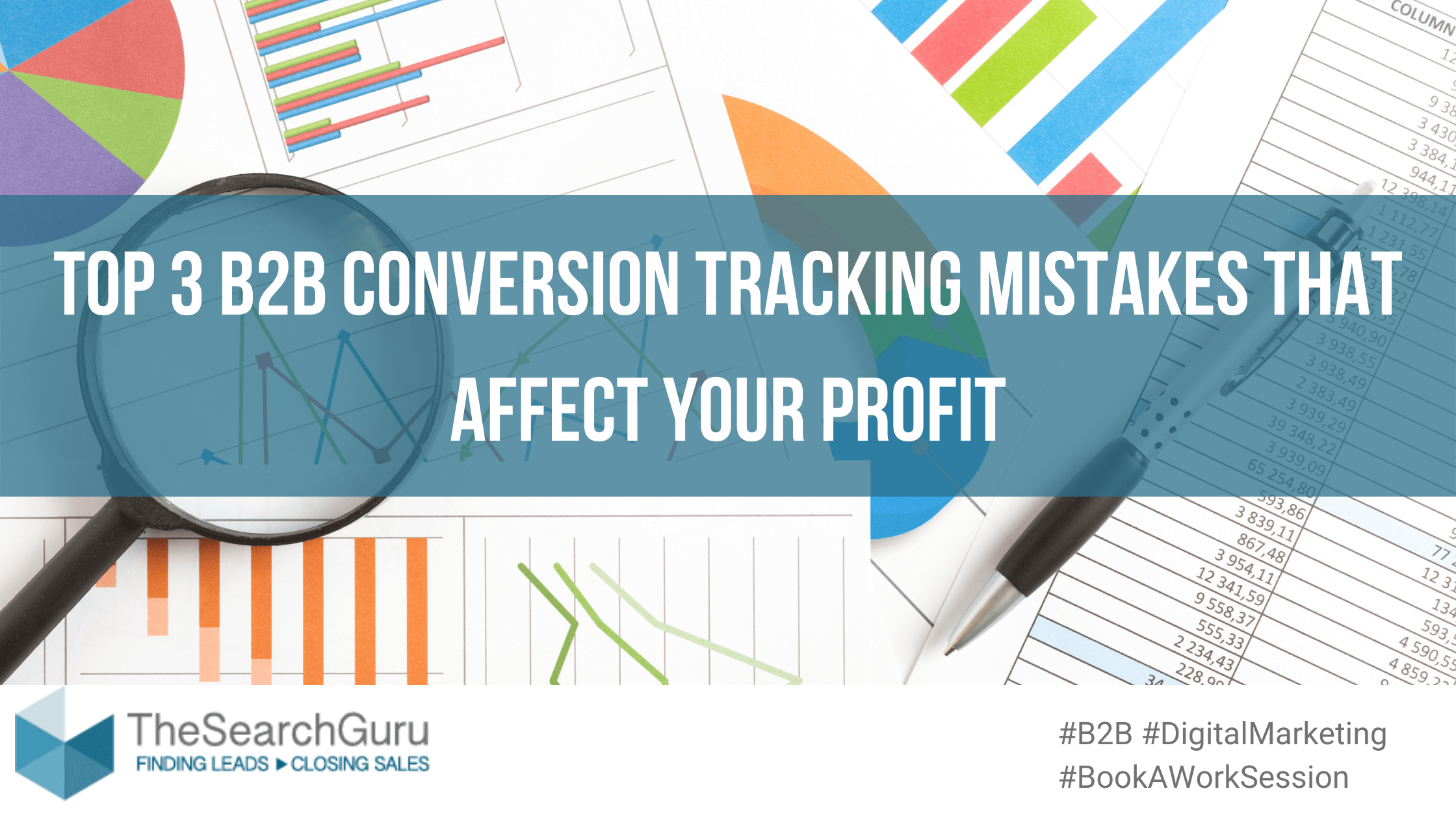Online marketing allows you the ability to capture information about your site’s visitors to better understand your marketing efforts. Thanks to analytics, you can understand what your customers search for, how they interact on your site, what device they are on, and the actions they take before they actually buy.
Conversion tracking can be tricky, especially for Business to Business (B2B) companies. Your leads can come in the form of several types of actions and a conversion can mean many things. So why bother? Because conversion tracking helps evaluate your marketing efficiency, saves money from allocating budget to low performing channels and improves profit by spending more on winning strategies.
Correct Conversion Tracking = Smarter Marketing Decisions = Less Cost for Higher Profit (More Money!)
Below are the top 3 B2B conversion tracking mistakes and how to avoid them (with examples):
 1. Defining Goals / Unclear Vision What to Track as Conversions
1. Defining Goals / Unclear Vision What to Track as Conversions
There can be many conversion points in your customer’s journey. From an unknown visitor to a lead, from a lead to an opportunity, and from an opportunity to a customer. From a visitor to a lead is a type of conversion, but that conversion is not as important as an opportunity to a customer. A customer equals money.
Example: A financial company set three conversion goals and assigned values to them.
- The types of conversions the financial company tracks are
- Clicks on resources / pages
- Application Start
- Application Finished
The mistake they made was that they assigned a greater value to their micro conversions (what’s not as important to them). The table below shows their goals and the values they assigned.

It doesn’t make sense that their most important goal of getting someone to complete an application has no value (dollar amount) assigned to it while someone just clicking on their resource page has a $400 value.
To fix their mistake, this financial company needed to understand their goals from least to most important and then assign the correct value to those goals. Once the right value was assigned to their goals, they could better understand their conversion funnel.
How You Can Avoid Making this Mistake: Separate your important (macro) goals vs your less important (micro) goals. Assign the correct value to align with the importance of the goals.
 2. Tracking Conversions on External Site
2. Tracking Conversions on External Site
In B2B marketing, tracking conversions may be a lot more complicated than just tracking visitors on your website. A conversion could be filling out a form or providing contact information as well as multiple clicks that could happen on an external site.
Example: A design company that makes on-brand graphic design delivers their design through a combination of a team of experienced designers and their design management platform.
- The types of conversions they track:
- New user creation
- Which users have placed projects in an organization
- Synching organization data with CRM platform, and surfacing insights to sales team
The issue they had with their tracking is that the evaluation of leads depended on information sent to their CRM, but none of the data was making it over to their CRM due to the change in their platform. They weren’t collecting any information on their leads.
To fix their mistake, they decided which data would be most useful to them by talking to their sales team and looking at what was missing from the active marketing campaigns. They implemented the connector to their CRM to be able to easily connect and share the data. Their analytics director created a series of “CRM data” tables and increased the frequency for these tables to submit the data several times per day, so they could get the most updated information multiple times a day instead of just once a day.
How You Can Avoid Making this Mistake: Improve your database by working with your sales and marketing team to identify the needed data for your campaigns. This in return improve your lead scoring and identify ways to avoid losing customers during the order process.
 3. Conversions Made Offline / Sales Happen Through Distributors
3. Conversions Made Offline / Sales Happen Through Distributors
B2B marketers need to track their online sources: website traffic, social media, blog traffic, email sign ups, etc. But how do you track conversions that are happening offline? Offline leads and sales are a important aspect of your B2B business.
Example: An indoor air quality company set up major goals and minor goals to be tracked.
The goal they set up were:
- Minor Goal: Purchase of spare parts.
- These happen via an Ecommerce store and can be tracked with an Ecommerce value.
- Major Goal: Sale of large houses’ air systems
- These happen through distributors, so the issue is that there is no tracking or goal value assigned to it.
The issue they had with their conversion tracking is that their marketing campaign results cannot be tracked against their major goal (the sale of large house air systems) because there is no goal value assigned.
To be able to track their major goal offline, they tracked distributors searches on their website. They gave the option to enter your zip code and get distributors closer to your area from there they were track phone calls from their site to distributors They created a list of names and phone numbers/emails as another step to track the interest of people. From there, they set up an event in analytics of clicking on the distributor search result after entering zip code.
Another option to fix this issue is to add a marketing automation platform to your site to better track the process of turning visitors to leads then to customers. With Marketing automation, you’re able to track the path of the visitors by getting their name / email, creating a lead for them, and continuing to follow their real path on your website. You can see what content they interact with and understand what works best or needs to be improved. If you have an app for online management or support center where they can register, you will be able to see which leads became customers as well.
How You Can Avoid Making this Mistake: Set up custom tracking for offline and distributor sales.
 Now what?
Now what?
Start by auditing your website tracking system. Figure out your goals and how you want to value them then set up your goals and assign the proper values. Once your conversion tracking is right, you’ll have the right data to make the right decisions. Periodically audit your goals and their priorities, your tracking codes and analytics, and overall efficiency of your marketing campaigns.
Let’s work on this together: book a free work session
All companies we speak with have unique problems, and we’ve yet to find anyone who isn’t primarily plagued by too few resources. Take us up on a free training/work session where we can discuss your unique problems and offer solutions from top B2B marketers. Book one here:






